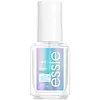What's inside
What's inside
 Key Ingredients
Key Ingredients

No key ingredients
 Benefits
Benefits

No benefits
 Concerns
Concerns

 Ingredients Side-by-side
Ingredients Side-by-side

Butyl Acetate
MaskingEthyl Acetate
PerfumingNitrocellulose
Acetyl Triethyl Citrate
MaskingIsopropyl Alcohol
SolventAdipic Acid/Neopentyl Glycol/Trimellitic Anhydride Copolymer
Styrene
PerfumingAcrylates Copolymer
Dimethyl Urea
Sucrose Benzoate
Stearalkonium Bentonite
Gel FormingDiacetone Alcohol
MaskingTitanium Dioxide
Cosmetic ColorantCitric Acid
BufferingPhosphoric Acid
BufferingTriethoxycaprylylsilane
Aluminum Hydroxide
EmollientButyl Acetate, Ethyl Acetate, Nitrocellulose, Acetyl Triethyl Citrate, Isopropyl Alcohol, Adipic Acid/Neopentyl Glycol/Trimellitic Anhydride Copolymer, Styrene, Acrylates Copolymer, Dimethyl Urea, Sucrose Benzoate, Stearalkonium Bentonite, Diacetone Alcohol, Titanium Dioxide, Citric Acid, Phosphoric Acid, Triethoxycaprylylsilane, Aluminum Hydroxide
Ethyl Acetate
PerfumingButyl Acetate
MaskingNitrocellulose
Propyl Acetate
PerfumingTributyl Citrate
SolventIsopropyl Alcohol
SolventTosylamide/Epoxy Resin
Adipic Acid/Neopentyl Glycol/Trimellitic Anhydride Copolymer
Stearalkonium Hectorite
Gel FormingAcrylates Copolymer
Benzophenone-1
UV AbsorberDimethyl Sulfone
SolventCalcium Sodium Borosilicate
Synthetic Fluorphlogopite
Hydrogenated Acetophenone/Oxymethylene Copolymer
Dimethicone
EmollientCitric Acid
BufferingOxidized Polyethylene
Acetyl Tributyl Citrate
MaskingCI 77120
Cosmetic ColorantAlumina
AbrasiveCalcium Aluminum Borosilicate
Colophonium
Silica
AbrasiveWater
Skin ConditioningTin Oxide
AbrasiveMagnesium Silicate
AbsorbentCalcium Pantothenate
Camellia Sinensis Leaf Extract
AntimicrobialAluminum Hydroxide
EmollientPhthalic Anhydride/Glycerin/Glycidyl Decanoate Copolymer
Acetone
SolventCI 77002
Cosmetic ColorantCI 77891
Cosmetic ColorantMica
Cosmetic ColorantCI 77491
Cosmetic ColorantCI 77499
Cosmetic ColorantCI 15880
Cosmetic ColorantCI 19140
Cosmetic ColorantCI 15850
Cosmetic ColorantCI 77400
Cosmetic ColorantCI 77288
Cosmetic ColorantCI 42090
Cosmetic ColorantCI 77510
Cosmetic ColorantCI 77000
Cosmetic ColorantCI 77163
Cosmetic ColorantCI 77266
Cosmetic ColorantEthyl Acetate, Butyl Acetate, Nitrocellulose, Propyl Acetate, Tributyl Citrate, Isopropyl Alcohol, Tosylamide/Epoxy Resin, Adipic Acid/Neopentyl Glycol/Trimellitic Anhydride Copolymer, Stearalkonium Hectorite, Acrylates Copolymer, Benzophenone-1, Dimethyl Sulfone, Calcium Sodium Borosilicate, Synthetic Fluorphlogopite, Hydrogenated Acetophenone/Oxymethylene Copolymer, Dimethicone, Citric Acid, Oxidized Polyethylene, Acetyl Tributyl Citrate, CI 77120, Alumina, Calcium Aluminum Borosilicate, Colophonium, Silica, Water, Tin Oxide, Magnesium Silicate, Calcium Pantothenate, Camellia Sinensis Leaf Extract, Aluminum Hydroxide, Phthalic Anhydride/Glycerin/Glycidyl Decanoate Copolymer, Acetone, CI 77002, CI 77891, Mica, CI 77491, CI 77499, CI 15880, CI 19140, CI 15850, CI 77400, CI 77288, CI 42090, CI 77510, CI 77000, CI 77163, CI 77266
Ingredients Explained
These ingredients are found in both products.
Ingredients higher up in an ingredient list are typically present in a larger amount.
Acrylates Copolymer is used as a film-forming agent and texture enhancer.
After applied, Acrylates Copolymer forms a thin film cover that helps skin feel more soft. It can help sunscreens become more water-resistant.
It is also used to make a product more thick.
Learn more about Acrylates CopolymerWe don't have a description for Adipic Acid/Neopentyl Glycol/Trimellitic Anhydride Copolymer yet.
Aluminum Hydroxide is a form of aluminum. It can be naturally found in nature as the mineral gibbsite. In cosmetics, Aluminum Hydroxide is used as a colorant, pH adjuster, and absorbent.
As a colorant, Aluminum Hydroxide may add opacity, or reduce the transparency. Aluminum hydroxide is contains both basic and acidic properties.
According to manufacturers, this ingredient is an emollient and humectant. This means it helps hydrate the skin.
In medicine, this ingredient is used to help relieve heartburn and help heal ulcers.
There is currently no credible scientific evidence linking aluminum hydroxide in cosmetics to increased cancer risk.
Major health organizations allow the use of aluminum hydroxide in personal care products and have not flagged it as a carcinogenic risk at typical usage levels.
Learn more about Aluminum HydroxideWe don't have a description for Butyl Acetate yet.
Citric Acid is an alpha hydroxy acid (AHA) naturally found in citrus fruits like oranges, lemons, and limes.
Like other AHAs, citric acid can exfoliate skin by breaking down the bonds that hold dead skin cells together. This helps reveal smoother and brighter skin underneath.
However, this exfoliating effect only happens at high concentrations (20%) which can be hard to find in cosmetic products.
Due to this, citric acid is usually included in small amounts as a pH adjuster. This helps keep products slightly more acidic and compatible with skin's natural pH.
In skincare formulas, citric acid can:
While it can provide some skin benefits, research shows lactic acid and glycolic acid are generally more effective and less irritating exfoliants.
Most citric acid used in skincare today is made by fermenting sugars (usually from molasses). This synthetic version is identical to the natural citrus form but easier to stabilize and use in formulations.
Read more about some other popular AHA's here:
Learn more about Citric AcidEthyl Acetate is a fragrance.
Isopropyl Alcohol is more commonly known as rubbing alcohol. It is most commonly used as a solvent, meaning it helps other ingredients dissolve.
This ingredient is an astringent alcohol. Astringent alcohols may also irritate skin as they high amounts may strip away your skin's natural oils.
Other types of astringent alcohols include:
According to the National Rosacea Society based in the US, you should be mindful of products with these alcohols in the top half of ingredients.
Any type of sanitizing product will have high amounts of alcohol to help kill bacteria and viruses.
Learn more about Isopropyl AlcoholWe don't have a description for Nitrocellulose yet.